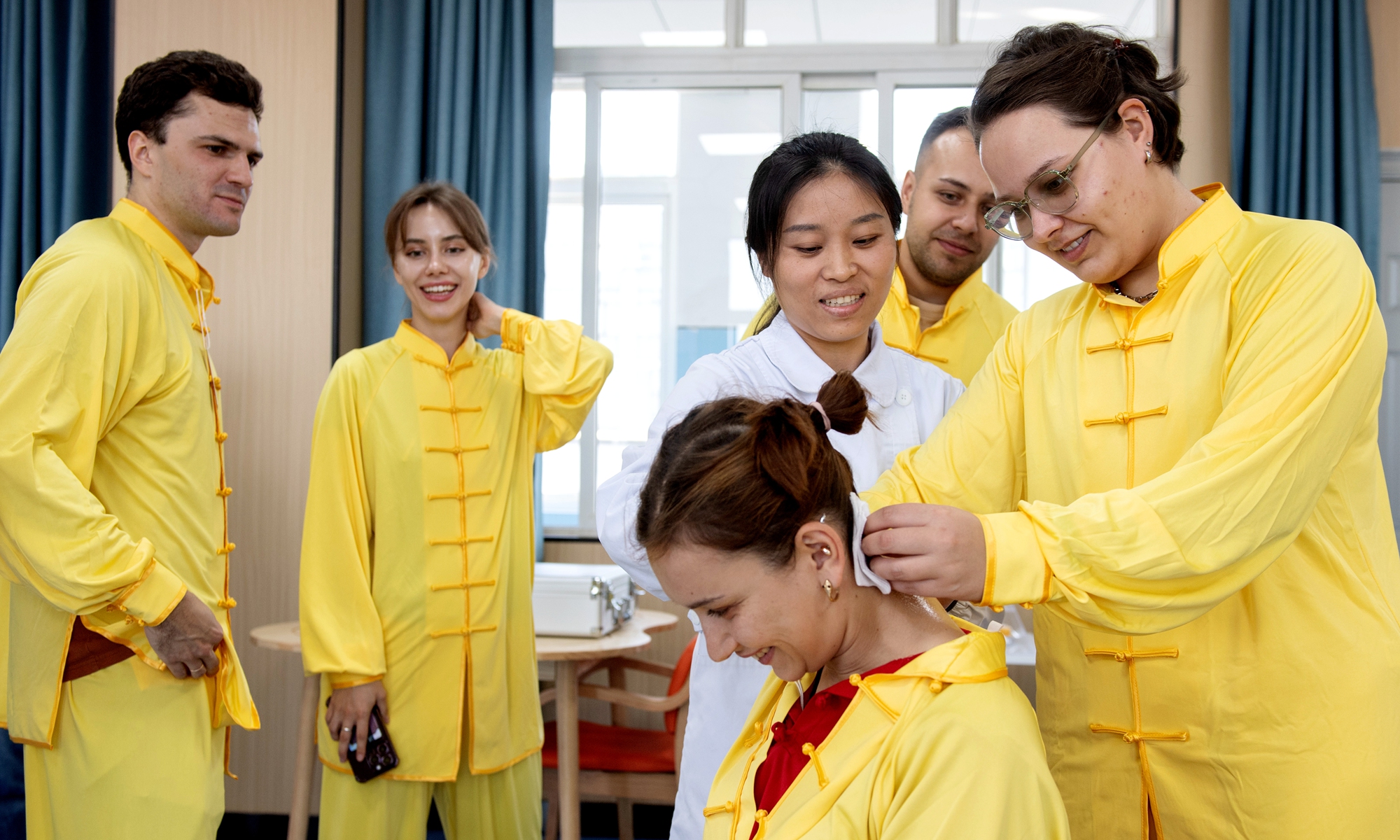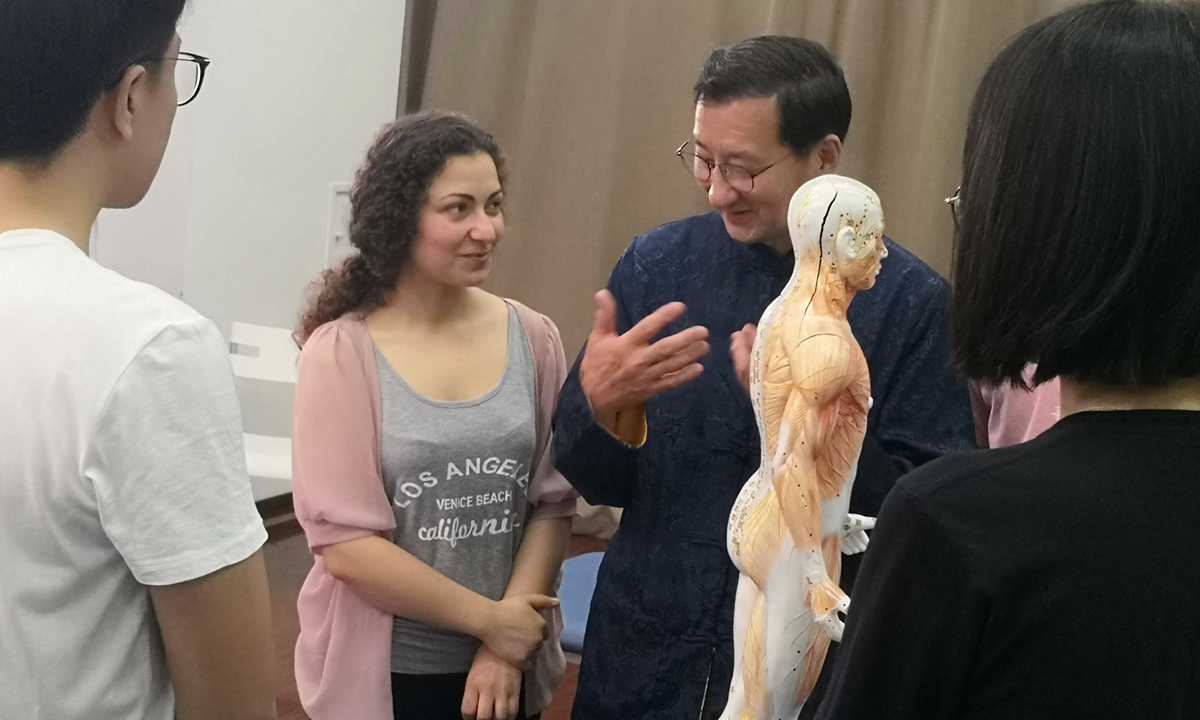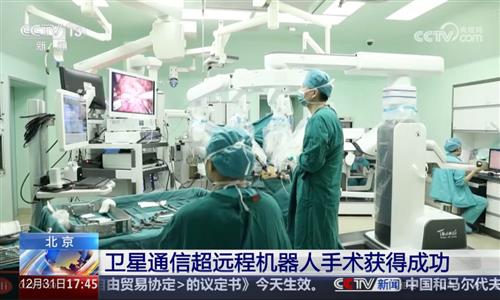International students experience the traditional Chinese therapy in Huzhou, East China's Zhejiang Province on November 1, 2023. Photo: VCG
Editor's Note:
Chinese President Xi Jinping often quotes an ancient saying on many diplomatic occasions: "No mountain or ocean can separate those who share the same aspirations." This powerful message underscores the undeniable force of friendship and cooperation in bridging hearts across nations, cultures, and civilizations. Inspired by President Xi's vision, people-to-people exchanges between China and the world have been flourishing.
People from diverse backgrounds and fields - united by common goals and dreams - traverse mountains and oceans to connect with each other. Through letters, face-to-face dialogues, and vibrant cultural events, they are collectively weaving a magnificent tapestry of building a community of shared future for humanity.
The Global Times presents "Intertwined Destinies, Shared Paths," a series spotlighting the touching stories written by these "friendship ambassadors." They are scholars pushing the boundaries of research, diplomats advocating for deeper cooperation on the global stage, artists igniting imaginations with their creations, and ordinary people extending heartfelt love beyond national borders driven by genuine sincerity.
Their tales illuminate the spark of cultural exchange, the driving force of technological innovation, the bountiful harvest of economic cooperation, and the enduring warmth of human connection - all contributing to a more peaceful, prosperous, and open world. This is the fourth installment of the series.

International students experience the traditional Chinese therapy in Huzhou, East China's Zhejiang Province on November 1, 2023. Photo: VCG
Indian Ocean. Reunion Island. A knock at the door interrupts a lecture on traditional Chinese medicine (TCM) taking place inside. A man in a wheelchair enters, looking at the lecturer with a pleading gaze.
"I can't move my back; I can't stand up," he said. "Can you help me?"
The lecturer, Li Zhengyu, one of China's most renowned acupuncturists and Tuina (Chinese massage therapy) experts, readily agreed. With the help of others, the patient, who had suffered an acute lumbar muscle sprain the night before, slowly lay down on a bed in the room. Li applied moderate manipulation to his back and then proceeded with acupuncture.
Li then asked the man to lie on the bed while he continued his lecture. About 20 minutes later, he returned to the bedside and removed the needles from the patient's acupoints. In front of the diverse body of students, the patient slowly stood up and ultimately walked out of the room without his wheelchair.
"It's amazing!" he said to Li before leaving, giving him a thumbs-up.
Li has heard variations of this praise numerous times from his international patients, students, and peers. As a frontline TCM doctor and a professor at the Shanghai University of Traditional Chinese Medicine (SHUTCM), the 65-year-old has taught tens of thousands of overseas students and treated countless patients globally over the last 30 plus years, with his fluent English, profound knowledge, and exceptional skills in TCM.
Li is among the growing number of Chinese TCM experts who actively promote it abroad, as the international community increasingly recognizes the value of this national treasure in benefiting more people from different countries and bridging their hearts. As proactive advocates for "TCM diplomacy," they, along with their many overseas students, keep working diligently to spread TCM culture globally.
"TCM is an essence of Chinese culture," Li told the Global Times. "As a Chinese national and a practitioner of TCM, I am honored to share this Chinese treasure with the world, which also serves as a beautiful calling card for cultural exchange between China and other countries."
'Seeing is believing'
Li witnesses the gradual process of TCM's recognition by the world.
He first encountered international patients in his work was in the early 1980s, when he was working at a hospital on bustling Qinghai Road in downtown Shanghai. The hospital was an outpatient department of the Yueyang Hospital of Integrated Traditional Chinese and Western Medicine affiliated to SHUTCM, now one of the most renowned TCM hospitals in Shanghai and even in the country.
At that time, shortly after China had begun its reform and opening-up, Nanjing Road West was filled with a large number of overseas tourists. Li recalled that each day, there were many overseas tourists who visited his hospital, but instead of directly consulting the doctors, they usually stood by and curiously watched Li and his colleagues perform acupuncture on patients.
"During Richard Nixon's visit to China in 1972, he observed how acupuncture was used for anesthesia, so many Westerners had a preliminary impression of our acupuncture," Li told the Global Times. "But they were generally unfamiliar with TCM, and only had a rough idea of it."
As one of the staffers with the best English at the hospital, Li often acted as a translator to introduce some basic TCM concepts to international visitors. In those days, he perceived a strong interest from the outside world in TCM, but their understanding was quite limited.
In Li's memory, an increasing number of international patients came to China to study TCM starting in the early 1990s. At Yueyang Hospital, Li began to treat international patients while also teaching short-term international students. "The US, France, Germany, Israel... as the reputation of TCM grew, student groups began arriving from all over the globe," said Li. He added that, members of these groups widely varied from medical students and healthcare professionals, to individuals from other fields. Their commonality was, as Li described, being highly curious about TCM, along with a hint of skepticism.
On numerous occasions, Li dispelled their doubts about TCM through practical demonstrations. Once, there was a surgeon from a US medical delegation who suffered from a lumbar disc herniation and had a small stool strapped to his back to alleviate the pain. Li told him that Tuina could effectively relieve his discomfort. Though a bit skeptical, the surgeon agreed to give it a try.
After only 15 minutes of Tuina, the surgeon immediately told Li that his back pain had significantly improved. He expressed his amazement, saying, "Seeing is believing; TCM really works."
Global students
In the early 2000s, as the pace of TCM expansion internationally accelerated, many Chinese universities successively launched international programs in TCM, welcoming people from around the world to come and learn about TCM techniques and culture in China.
Li's SHUTCM, for instance, has various international training courses and summer school projects, and began enrolling undergraduate students in TCM (acupuncture) with courses taught entirely in English in 2012. At the institution's invitation, Li later became an English-language instructor for international students at the university. At the classes for international students, Li usually downplays the abstract and difficult theoretical concepts in TCM, and focuses more on practical, effective techniques. "Tuina and acupuncture can show results quickly in clinical practice; sometimes pain relief can be achieved in just one or two minutes," he explained.
Iranian student Farimah Shokri shared a memorable moment in Li's class during a practical session in Tuina therapy. "I recall vividly how he demonstrated a specific Tuina technique that instantly alleviated chronic muscle pain in a patient," Shokri told the Global Times. "Witnessing this firsthand reinforced my confidence in TCM's efficacy and potential."

Doctor Li Zhengyu teaches TCM theory to his student. Photo: Courtesy of Li
Apart from practical techniques, Li also highlights the traditional Chinese culture embedded in TCM, which he believes is a vibrant channel to know about the profound Chinese culture and philosophy.
Shokri feels that studying TCM has undoubtedly deepened her appreciation and understanding of traditional Chinese culture. She believes that the most compelling Chinese philosophical concept is "yin and yang" that emphasizes the balance of opposing forces in all aspects of life.
Studying TCM in Shanghai since 2020, the now 25-year-old chose to become a TCM practitioner specializing in Tuina therapy after graduation. She joined a renowned TCM clinic in Iran, where she treats conditions such as musculoskeletal pain, stress, and insomnia. "Beyond clinical practice, I have also engaged in patient education, helping individuals understand the principles of TCM and how to integrate them into their daily lives to promote holistic health and well-being," she said.
Saša Balaneskoviki is a teacher of Qigong and Taijiquan (body exercises related to China's martial arts), and a practitioner of acupuncture and Tuina in Serbia. He learned the basics of Tuina from Li when studying acupuncture in Shanghai in 2017.
In his home country, Balaneskoviki has organized dozens of visits by Chinese TCM, Qigong, and Taijiquan professors and masters, and has also held conferences, workshops, and webinars under these themes, engaging in the overseas spread of TCM and traditional Chinese culture.
"TCM is well known in Serbia," he told the Global Times.
Growing recognition
TCM had spread to 196 countries and regions around the world, with the number of people treated in TCM exceeding one-third of the world's total population, reported the Xinhua News Agency in September 2023. With the establishment of more overseas TCM centers, clinics, and collaborative programs, TCM not only benefits people globally, but also serves as a strong bridge for people-to-people exchanges between China and other countries, gaining increasing recognition and praise overseas.
Li recalled an occasion, when he traveled to a US city for preliminary preparations for a China-US cooperative hospital project. This project was initially proposed, because the US believed that the city was facing a serious opioid abuse problem, and thought TCM seems to offer a potential solution.
There, Li met a private doctor of a senior US official, who complained about the pain in his hand. Li told him that the pain-relieving effects of acupuncture and Tuina could significantly replace opioid medications. Li then treated him with the "rolling manipulation" technique and "Yizhichan-pushing manipulation" for 10 minutes, and the results were quickly noticeable: "I feel so much better!" the private doctor exclaimed.
Li himself is vigorously involved in the formulation of international standards for TCM. Since 2016, he has been invited to participate in the revisions of the operational specifications for Tuina techniques and the standards for TCM terminology initiated by the WHO.
Earlier, at an International Organization for Standardization (ISO) meeting, when faced with a suggestion from South Korean experts to translate TCM as "Han Medicine," Li turned it down. "TCM was originated and flourished in China," he said. "We can't lose the word 'China' in the translation."
Now, Li has retired from SHUTCM, but he continues to see patients at a hospital in Shanghai, treating both Chinese and foreign patients with TCM. Like sparks spreading warmth, Li and his global students are promoting TCM culture in various ways across various fields.
For decades, they have witnessed the international community's journey with TCM from unfamiliarity to familiarity, and from skepticism to acceptance. This transformation is the result of the tireless efforts of many individuals like Li, as well as the growing confidence of Chinese people in their culture.
"TCM culture is one of the most representative aspects of the Chinese culture," Li told the Global Times. "Being able to contribute to the promotion of TCM, and to share with the world the precious concepts of Chinese culture and philosophy, I always feel deeply honored."
Related:








